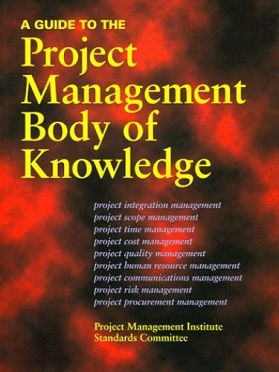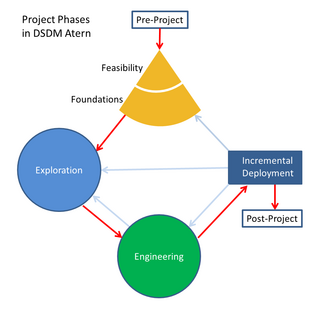Related Research Articles
Project management is the process of leading the work of a team to achieve all project goals within the given constraints. This information is usually described in project documentation, created at the beginning of the development process. The primary constraints are scope, time, and budget. The secondary challenge is to optimize the allocation of necessary inputs and apply them to meet pre-defined objectives.
Software testing is the act of examining the artifacts and the behavior of the software under test by validation and verification. Software testing can also provide an objective, independent view of the software to allow the business to appreciate and understand the risks of software implementation. Test techniques include, but are not necessarily limited to:

The Project Management Body of Knowledge (PMBOK) is a set of standard terminology and guidelines for project management. The body of knowledge evolves over time and is presented in A Guide to the Project Management Body of Knowledge, a book whose seventh edition was released in 2021. This document results from work overseen by the Project Management Institute (PMI), which offers the CAPM and PMP certifications.
Project management software (PMS) has the capacity to help plan, organize, and manage resource tools and develop resource estimates. Depending on the sophistication of the software, it can manage estimation and planning, scheduling, cost control and budget management, resource allocation, collaboration software, communication, decision-making, quality management, time management and documentation or administration systems. Numerous PC and browser-based project management software and contract management software products and services are available.
The Rational Unified Process (RUP) is an iterative software development process framework created by the Rational Software Corporation, a division of IBM since 2003. RUP is not a single concrete prescriptive process, but rather an adaptable process framework, intended to be tailored by the development organizations and software project teams that will select the elements of the process that are appropriate for their needs. RUP is a specific implementation of the Unified Process.
A project manager is a professional in the field of project management. Project managers have the responsibility of the planning, procurement and execution of a project, in any undertaking that has a defined scope, defined start and a defined finish; regardless of industry. Project managers are first point of contact for any issues or discrepancies arising from within the heads of various departments in an organization before the problem escalates to higher authorities, as project representative.
Software development is the process of conceiving, specifying, designing, programming, documenting, testing, and bug fixing involved in creating and maintaining applications, frameworks, or other software components. Software development involves writing and maintaining the source code, but in a broader sense, it includes all processes from the conception of the desired software through to the final manifestation of the software, typically in a planned and structured process. Software development also includes research, new development, prototyping, modification, reuse, re-engineering, maintenance, or any other activities that result in software products.
A modeling language is any artificial language that can be used to express information or knowledge or systems in a structure that is defined by a consistent set of rules. The rules are used for interpretation of the meaning of components in the structure Programing language.

Dynamic systems development method (DSDM) is an agile project delivery framework, initially used as a software development method. First released in 1994, DSDM originally sought to provide some discipline to the rapid application development (RAD) method. In later versions the DSDM Agile Project Framework was revised and became a generic approach to project management and solution delivery rather than being focused specifically on software development and code creation and could be used for non-IT projects. The DSDM Agile Project Framework covers a wide range of activities across the whole project lifecycle and includes strong foundations and governance, which set it apart from some other Agile methods. The DSDM Agile Project Framework is an iterative and incremental approach that embraces principles of Agile development, including continuous user/customer involvement.
In organizational studies, resource management is the efficient and effective development of an organization's resources when they are needed. Such resources may include the financial resources, inventory, human skills, production resources, or information technology (IT) and natural resources.

Business process modeling (BPM) in business process management and systems engineering is the activity of representing processes of an enterprise, so that the current business processes may be analyzed, improved, and automated. BPM is typically performed by business analysts, who provide expertise in the modeling discipline; by subject matter experts, who have specialized knowledge of the processes being modeled; or more commonly by a team comprising both. Alternatively, the process model can be derived directly from events' logs using process mining tools.
Requirements management is the process of documenting, analyzing, tracing, prioritizing and agreeing on requirements and then controlling change and communicating to relevant stakeholders. It is a continuous process throughout a project. A requirement is a capability to which a project outcome should conform.
Legacy modernization, also known as software modernization or platform modernization, refers to the conversion, rewriting or porting of a legacy system to modern computer programming languages, architectures, software libraries, protocols or hardware platforms. Legacy transformation aims to retain and extend the value of the legacy investment through migration to new platforms to benefit from the advantage of the new technologies.
A Risk Breakdown Structure (RBS) within risk management is a hierarchically organised depiction of the identified project risks arranged by category.
A glossary of terms relating to project management and consulting.
Business process management (BPM) is the discipline in which people use various methods to discover, model, analyze, measure, improve, optimize, and automate business processes. Any combination of methods used to manage a company's business processes is BPM. Processes can be structured and repeatable or unstructured and variable. Though not required, enabling technologies are often used with BPM.
In software engineering, a software development process is a process of dividing software development work into smaller, parallel, or sequential steps or sub-processes to improve design and/or product management. It is also known as a software development life cycle (SDLC). The methodology may include the pre-definition of specific deliverables and artifacts that are created and completed by a project team to develop or maintain an application.
Capital program management software (CPMS) refers to the systems that are currently available that help building owner/operators, program managers, and construction managers, control and manage the vast amount of information that capital construction projects create. A collection, or portfolio of projects only makes this a bigger challenge. These systems go by different names: capital project management software, construction management software, project management information systems.
The following outline is provided as an overview of and topical guide to project management:
ISO 21500, Guidance on Project Management, is an international standard developed by the International Organization for Standardization, or ISO starting in 2007 and released in 2012. It was intended to provide generic guidance, explain core principles and what constitutes good practice in project management. The ISO technical committee dealing with project management, ISO/PC 236 was held by the American National Standards Institute (ANSI) which had approved four standards that used Project Management Institute (PMI) materials, one of which was ANSI/PMI 99-001-2008, A Guide to the Project Management Body of Knowledge - 4th Edition.
References
- 1 2 "Project Management Information System (PMIS)". Project-Management-Knowledge.com. Retrieved 13 November 2009.